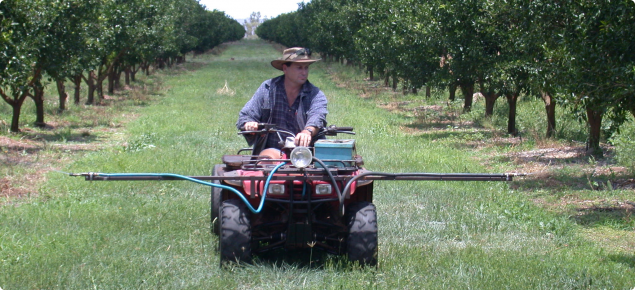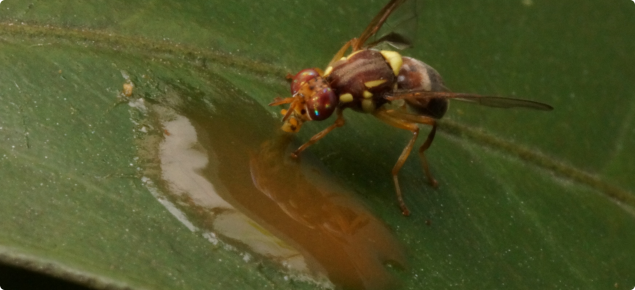When do I need to start?
- Commence weekly baiting when fruit is half size. Where medfly pressure is high, start after fruit set.
- Apply baits at least once per week as the insecticide mixure is not effective beyond this. Do not apply bait to the same tree more than once a week, due to potential problems with phytotoxicity.
- Bait twice weekly if trapping indicates that fly numbers are constantly > 1 fly/trap/week. Alternate the rows or trees you spray, so you are only baiting any tree only once in any one week. Look for stings and consider cover spraying if necessary.
- Baiting your entire orchard is more effective than baiting just a few blocks.
- Choose a regular morning and day for your baiting, and program it into your orchard management plans.
- Reapply bait if it rains.
- Bait wind breaks and other non-fruit evergreen trees in the orchard.
Best time of day to bait
-
Bait in the morning to the foliage (aim for middle to top of tree) so that fresh bait is available when flies start to feed.
When can I stop baiting?
- Continue baiting a block for at least four weeks after harvest, to ensure that flies emerging from the soil are killed.
- Continue to treat any citrus trees (regardless of whether they have fruit) while fruit is on the other trees, as citrus are favoured resting places for Medfly.
- Baiting in autumn is also recommended as Medflies present are the source of next year's population.
How?
- Spot application. Apply 50-100 mL in coarse droplets (4-6mm in size) to foliage. Apply bait to every tree in a row, alternate sides that you bait each week to avoid phytotoxicity.
- Continuous stream method. Apply a continuous stream to each tree in a row. The spray will be broken up when it hits the foliage. With a spray rig set up to spray both sides of a row, travel up and down every second row so that trees are not being double sprayed.
How much bait do I apply per hectare?
- Depends on the product, from 1 up to 20 L/ha.
What can I use?
-
There are two key components to a foliar bait mixture for controlling Mediterranean fruit fly: the protein to attract the fruit fly to feed and a small amount of an insecticide to kill the fruit fly.
-
A third component is something to thicken and stabilise the bait mixture, reported to reduce drying in hot weather and extend the effective life of the bait mixture. This practice is still experimental and growers should monitor its effectiveness.
| Protein | Example of product names | Rate of application* |
|---|---|---|
| Plant-based protein | NATFLAV 500® Fruit fly lure Bugs for Bugs Fruit Fly Lure® Flavex® | Add 700 to 2000mL of protein for every 100L of water plus insecticide. Add protein first then add water plus insecticide. The variable rate is to account for variations in label rates and phytotoxicity. |
| Animal-based protein | Cera Bait®
| Continuous stream application: Spot application: |
| Naturalure | Naturalure™ fruit fly Bait concentrate | Naturalure is an ‘all in one’ protein plus insecticide concentrate. For rate and mixing details, see Table 3. |
| Product | Example of product names | Rate of application |
|---|---|---|
| Xanthan gum | Xanthan gum Keltrol gel | Add 5g of product per litre of final bait mixture. Dissolve the powder in a small amount of water first, use of a ‘vortex’ mixing unit is helpful, then add slowly to the bait mixture ensuring constant agitation of mixture. |
| Guar gum | Guar gum |
| Crop | Insecticide | Example of product names | Rate of application | Withholding period (days) after final application |
|---|---|---|---|---|
| All | Trichlorfon (500g/L) | Dipterex 500SL® Lepidex 500® | 780mL in 100L of water plus protein | 2 days |
| All | Maldison | Maldison 500® | 700mL in 100L of water plus protein | 3 days |
| All | Maldison (440 g/L) | Fyfanon™ 440EW | 700mL in 100L of water plus protein | 3 days |
| All | Spinosad | Naturalure™ fruit fly Bait concentrate | Mix 1 part Naturalure with 6.5 parts water. This is a complete bait product, so no further protein is required. | Not required when used as directed |
| Non-crop vegetation; perimeter baiting | Spinosad | Naturalure™ fruit fly Bait concentrate | Dilute to 1:6.5 or use as a concentrate 1:1.5 parts water. This is a complete bait product, no further protein is required. | Not required when used as directed |
Common problems
If Medfly numbers continue to increase, application may be incorrect.
If this occurs, check the following:
- Are you using the correct formulation? Check against Tables 1 and 3.
- How old is the insecticide and protein? Potency or attraction can decrease with time.
- Have you been mixing new batches of bait each time that you use it? The potency of the bait mixture decreases and all bait should be used on the same day that it is mixed.
- What is the pH of your water? High pH can degrade some insecticide formulations rapidly. A pH range between 5.6 and 6.5 is preferred.
- Is the nozzle wide enough to deliver a coarse spray? When sprayed, the bait should form large droplets on the foliage of the tree. If droplets are too fine, they will dry out rapidly and loose potency.
- Is enough bait being applied? Are you applying bait frequently enough? Calibrate your equipment to ensure you are putting out what you think you are.
- Has it been a particularly wet season? Rain washes off the bait and it should be re-applied after rain.
- Has orchard hygiene been maintained? If not, Medfly will continue to emerge from infested fruit and re-invade treated areas.
Contact
Commercial and industry enquiries should be directed to Medfly Compliance, all public enquiries should be directed to PaDIS.



